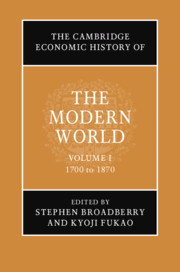Book contents
- The Cambridge Economic History of the Modern World
- The Cambridge Economic History of the Modern World
- The Cambridge Economic History of the Modern World
- Copyright page
- Contents
- Figures
- Tables
- Contributors to Volume I
- Preface and Acknowledgements
- Introduction to Volume I
- Part I Regional Developments
- Part II Factors Governing Differential Outcomes in the Global Economy
- 12 Population and Human Development since 1700
- 13 Proximate Sources of Growth: Capital and Technology, 1700–1870
- 14 Underlying Sources of Growth: First and Second Nature Geography
- 15 Institutions
- 16 Consequences of Growth: Living Standards and Inequality
- 17 International Transactions: Real Trade and Factor Flows
- 18 Monetary Systems and the Global Balance of Payments Adjustment in the Pre-Gold Standard Period, 1700–1870
- 19 War and Empire, 1700–1870
- Index
- References
12 - Population and Human Development since 1700
from Part II - Factors Governing Differential Outcomes in the Global Economy
Published online by Cambridge University Press: 03 June 2021
- The Cambridge Economic History of the Modern World
- The Cambridge Economic History of the Modern World
- The Cambridge Economic History of the Modern World
- Copyright page
- Contents
- Figures
- Tables
- Contributors to Volume I
- Preface and Acknowledgements
- Introduction to Volume I
- Part I Regional Developments
- Part II Factors Governing Differential Outcomes in the Global Economy
- 12 Population and Human Development since 1700
- 13 Proximate Sources of Growth: Capital and Technology, 1700–1870
- 14 Underlying Sources of Growth: First and Second Nature Geography
- 15 Institutions
- 16 Consequences of Growth: Living Standards and Inequality
- 17 International Transactions: Real Trade and Factor Flows
- 18 Monetary Systems and the Global Balance of Payments Adjustment in the Pre-Gold Standard Period, 1700–1870
- 19 War and Empire, 1700–1870
- Index
- References
Summary
This chapter examines relationships between demographic change and economic growth in the period 1700–1870. Traditional models of the demographic transition assumed that economic growth drove declines in mortality and fertility. However, such models cannot account for some of the main features of the transition. These include the early onset of initial mortality declines, widespread rises in fertility, and the weak correspondence between mortality levels and individual or national income at the beginning of the transition. Examination of pre-transitional demographic regimes indicates that mortality often rose with increasing urbanization and globalization, even as famine disappeared, and that social status gradients in survival were rare. Moreover, fertility was regulated, either within marriage or by limitations on marriage, in most societies, in contrast to the Malthusian view that mortality was the dominant form of population regulation. Early declines in major epidemic diseases allowed more modern gradients of health for wealth to emerge, and we argue that the causal relationships between economic growth and human capital were bi-directional, and driven in the early stages by mortality improvements. However, early gains in longevity were generally accompanied by rising fertility, leading to unprecedented population growth and unfavourable dependency ratios during the early phases of economic development.
Keywords
- Type
- Chapter
- Information
- The Cambridge Economic History of the Modern World , pp. 289 - 311Publisher: Cambridge University PressPrint publication year: 2021

